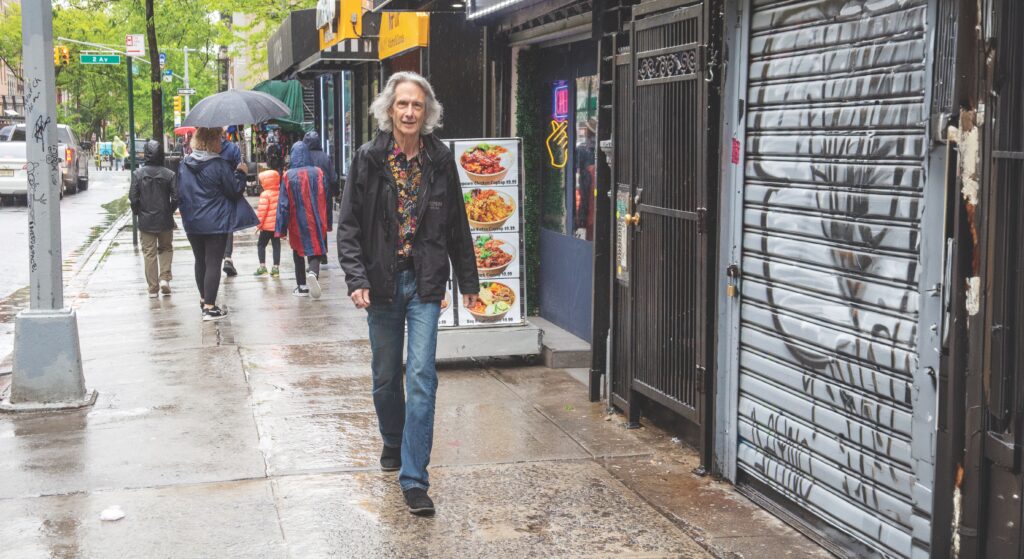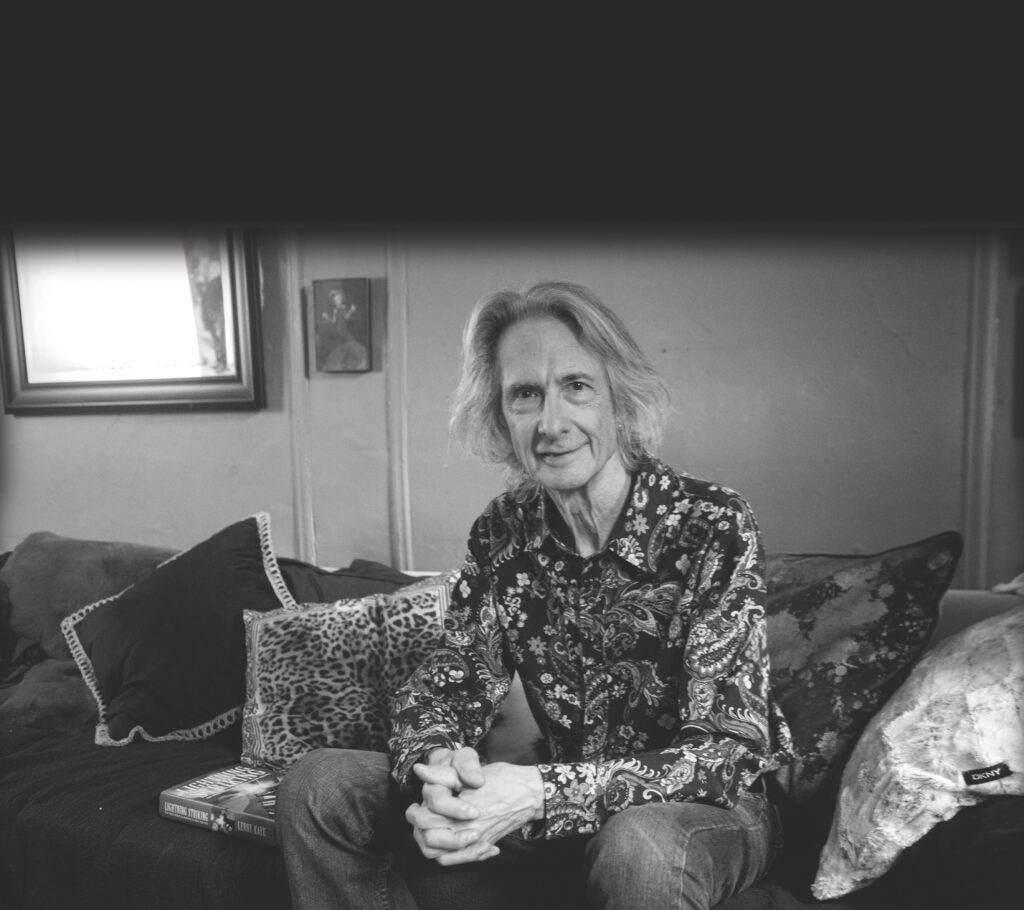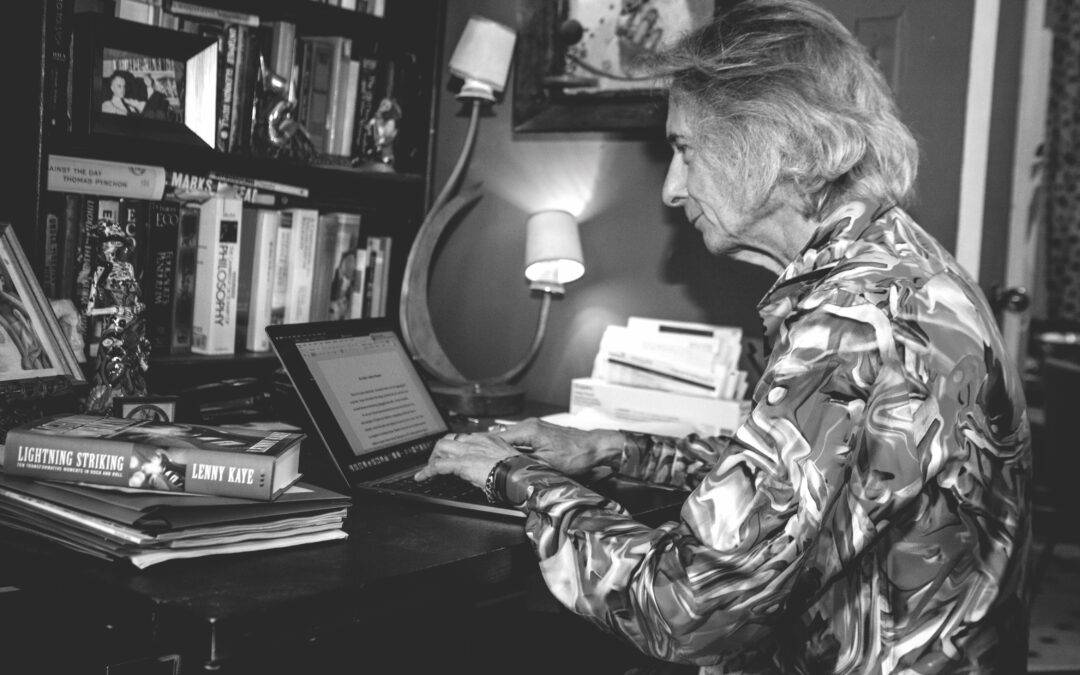If Patti Smith is the godmother of punk, then Lenny Kaye is its godfather. But he is also a writer, composer, record producer, and the keeper of an encyclopedic knowledge of rock n’ roll. He lives and breathes it, and his timeline coincides with the origins of the form.
By Deborah L. Martin
Photography by Bob Gruen
*Cover story from DOWNTOWN Summer 2024
CREATIVE ENDEAVORS NEED A PRACTITIONER, a witness, and a documentarian, and Lenny Kaye is all three. He was born around the same time rock and roll was born. The frequencies wormed their way into his bloodstream, so much so that he eventually became a chapter in the story and a witness from a position deep inside the belly of the beast. Kaye says, “What I’m most interested in is the moment that the seed is planted, before it becomes Punk or whatever, the weird cosmic dust before it starts forming into a planet. The moment Elvis said ‘I gotta go in there and make a record.’ The thing that draws him to that door.”

“What I am most interested in is the moment that the seed is planted, before it becomes punk or whatever, the weird cosmic dust before it starts forming into a planet.”
His book, Lightning Striking: Ten Transformative Moments in Rock and Roll is a history of the genre through his eyes. As he writes in the introduction, “Everywhere makes music. Everywhen makes music. But where and when space and time align, undercurrents spinning into whirlpools, stars binarying, trends signifying and amplifying, a mile marker notches the road map of musical cartography. An energy locus.” Though Kaye has singled out 10 moments—Memphis in 1954, San Francisco in 1967, New York City in 1975 to name a few—he is really telling the story of how sound weaves its way from back rooms, campfires, churches, and street corners, to ultimately end up pressed into wax and vinyl in tiny studios, spinning into the bedrooms, clubs, and radio stations of America, and changing everything in its path. “I was a teenager in rock’s glorious adolescence in the ’60s and I’ve kind of moved in parallel with its transformations. It’s not a memoir, I’m not that interested in myself frankly,” Kaye shares. “It’s an observation where I am a minor character, either as participant or witness.”
His own transformative moment was the result of an article he wrote for Jazz & Pop magazine, called “The Best of Acapella.” Kaye says, “Acapella was a very small, niche genre that ran from the Bronx down to Philadelphia, mostly promoted by oldies record stores. It was the dying embers of doo-wop music before it was supplanted by the new music of The Beatles.” The article resonated with Patti Smith, who was from South Jersey. “Many of the songs that I mentioned, “My Hero,” by Harold Melvin and The Blue Notes, “Today is the Day,” by Maureen Gray, or “Bristol Stomp” by The Dovells, were touchstones of Patti’s youth. And so, she came to visit me in the record store on Bleecker Street, where I worked.” They bonded over their love of rock ‘n’ roll. “I’d put on our favorite records, and we’d dance around the store. We connected with our musical impulse, and both of us appreciate the glory of the written word.”
Their first performance together was for the Poetry Project in the basement of St. Mark’s Church in-the-Bowery in February of 1971. Did lightning strike at that moment? Kaye says, “You can’t move these things forward, they have their own timeframe. If we would’ve said after our first reading, ‘Hey, let’s have a rock band,’ it would’ve sounded like a dozen other rock bands forming at the same time.” They started performing regularly in 1973, with Kaye on guitar, Patti singing, and eventually Richard Sohl on piano. “We were just a weird trio, a strange kind of cabaret poetry improv that had an effect on an audience, but we didn’t know why.” They coalesced when they added Ivan Král on guitar and Jay Dee Daugherty on drums. Their first single, “Hey Joe/Piss Factory,” was recorded at Electric Lady Studios on June 5, 1974—50 years ago—and was funded by Robert Mapplethorpe and produced by Kaye. A year later they would be back in the studio recording Horses, which is widely regarded as the first punk album.

The difference between what we listened to in the 1940s and what we listen to now is massive. But no matter how different the style of music is, the essence of song is the same.”
Kaye’s trajectory as a seeker of musical moments was cemented in 1972 when he created a compilation album for Jac Holzman, the founder of Elektra Records, called Nuggets: Original Artyfacts from the First Psychedelic Era, 1965-1968. “Jac didn’t want the classic hits. He wanted me to find the hidden track on an album that maybe had a hit on it, the songs that were left by the wayside.” Kaye says that Holzman wasn’t particularly into rock music until later when he signed bands like Love and The Doors. “He appreciated these wild card songs and gave me pretty much carte blanche to put them together. It’s remarkable when I think back on that.”
Kaye notes that there was a tremendous cultural shift going on in the world during that period when his chosen “nuggets” were made. “This is the time when the music moved from being teen pop to being art with all the pluses and minuses that would imply. I saw the Nuggets era, that little five-year chunk, as a transition period. But I think that said more about where I was on the timeline, because music is always in transition. In the early ’70s, it was in transition to become what we refer to as punk, whatever that is.” In fact, Kaye’s liner notes mention punk rock—it is one of the earliest references to the genre he helped create.
What are today’s Nuggets? “If I was going to put together a Nuggets for now, I have to say that we are in a great female era where you have Taylor Swift and Katy Perry, and people like GAYLE with that great song, “abcdefu.” And the Norwegian artist Annie with “The Streets Where I Belong” which has been in my top 10 for the past year. These are great records.”
Like all things, music exists on a continuum. Kaye points out that though the timeline is peppered with seismic genre shifts, in fact it all fits together like pieces of a linear puzzle. “Music will always progress in a way that seems like it’s overthrowing the old order. The difference between what we listened to in the 1940s and what we listen to now is massive. But no matter how different the style of music is, the essence of song is the same. It’s all about, I need love. I don’t have love. Who am I gonna become?” DTM
Photography: Bob Gruen @bob_gruen
Stylist: Mimi Fisher @themimifisher @judycaseyinc
Groomer: Donna Fumoso @donnafumoso @nextartists
Clothing: On cover, jacket by Vestium. Opening spread, custom ‘Nuggets’ silk shirt by Vestium. Other clothing Kaye’s own.

